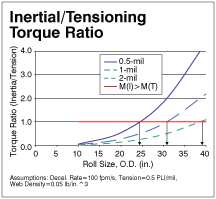Time for Unwinding Upgrade?
- Published: September 01, 2009, By By Timothy J. Walker Contributing Editor
How do you know when its time to upgrade from a brake-controlled to a driven unwinding process? When an unwinding roll is small and speeds are slow, you may not notice the tension upsets that occur during acceleration and deceleration, but when was the last time your customer asked for smaller rolls and your boss told you to run your process slower? Never? Yeah, that's what I thought.
As you start pressing your old braked unwind into more challenging service, the most obvious sign that you might benefit from a driven unwind is whether your web loses most or all of its tension during deceleration — something that commonly occurs on braked unwinds of a slitter/rewinder.
Stopping a large diameter unwinding roll involves two opposing torques. The unwind brake torque pulls backwards to create the desired tension at the roll's outer radius. The spinning roll's mass creates an inertial torque that pushes the roll forward. If you try to decelerate the roll too quickly, the inertial torque will overwhelm the braking torque. When this happens, the unwinding roll will not stop as rapidly as the rest of the machine, and the excess web will pay out into looseness or onto the floor.

A slack web at slitting is rarely a good thing. The loose web may fall out of a web guide sensor, wrap a roller, slip on rollers and get scratched, and shift laterally, losing your edge trim. Even short of slackness, the inertial torque can create a big tension upset that may lead to poor slit quality, wrapping rollers, and web breaks.
To determine when your product needs a driven unwind to avoid inertia-related tension losses and associated problems, you have to calculate these two opposing torques. The tensioning torque is easy to calculate; just multiply the total tension force by the roll radius. This will increase linearly with tension and radius. It also will increase with web thickness, as many products run at a tension proportional to thickness (keeping tensile stress and strain constant).
Calculating inertia torques is a little more complicated. The inertial torque is related to mass and radial deceleration. The radial deceleration is proportional to line speed, roll diameter, and deceleration time. The inertia will be proportional to your material density and roll geometry, especially diameter. Inertial torque will go up directly with density but go up much faster with diameter. A large roll turns at slower rpms than a small roll, so this helps reduce the deceleration rate, but increasing diameter adds mass more quickly, making inertial torque increase with the square of diameter.
Example | How big does a roll of polyester film need to get for a driven unwind to make sense? On the tensioning side, let's assume a lower-end tension of 0.5 PLI/mil of thickness (500 psi stress). On the inertia side, let's assume a fairly aggressive deceleration of 100 fpm in 1 sec.
At what diameter does the torque from inertia overcome the tensioning torque? For a 2-mil polyester film running at 1 PLI, the roll's inertia will drive the web into slackness during the 100 fpm/s deceleration if the roll diameter is 39 in. (and cut the tension in half at 31-in. dia). The problematic diameters are smaller for a lower-tensioned web, dropping to 24 in. for slackness and 20 in. to cut tension in half with 0.5-mil web running at 0.25 PLI.
You can get by with a braked unwind if you stay under these diameters, run higher tensions, reduce your deceleration rates, or run material less dense than polyester film. Driving your unwinding roll doesn't guarantee you won't have tension upsets, but at least a properly sized motor has the capability, when combined with a good inertia compensation control software, to smoothly accelerate and decelerate your big rolls.
Web handling expert Tim Walker, president of TJWalker+Assoc., has 25 years of experience in web processes, education, development, and production problem solving. Contact him at 651-686-5400; tjwalker@tjwa.com; www.webhandling.com.










